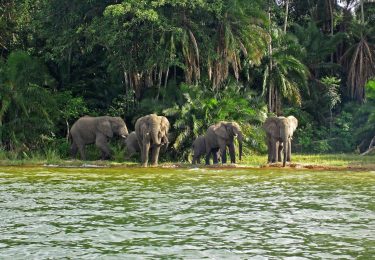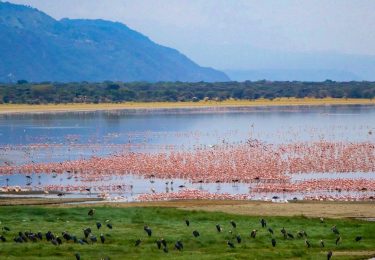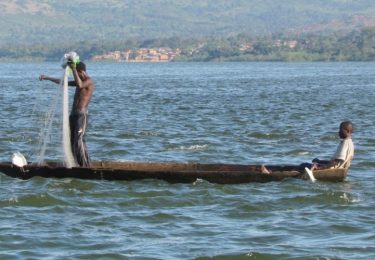- Home
- About Us
- Uganda safaris
- Long Safaris
- Short Safaris
- Day Short Safaris
- 1 Day Entebbe Botanical gardens weekend birding excursion
- I Day Entebbe City Tour
- 1 Day Jinja, Mabira, Ssezibwa Tour
- 1 Day Jinja Source of the Nile tour
- Lake Victoria Sunset Cruises
- 1 Day Kampala City Tour
- 1 Day Mabamba Shoebill Stork And Birding Tour
- 1 Day Makanaga Shoebill And Birding Trip
- 1 Day Ngamba Island Boat And Chimpanzee Excursion
- Other Tours
- Gorilla Safaris
- Uganda Gorilla safaris
- 4 Days Mgahinga Bwindi gorilla and golden monkey trekking safari
- 3 Days Mgahinga Gorilla trekking safari
- 5 Days Mgahinga Gorillas, Golden Monkey And Lake Bunyonyi Tour
- 5 Days Gorillas And Wildlife, L.Mburo, Bwindi and L. Bunyonyi
- 8 Days Wildlife, Gorillas, Golden Monkeys Trip
- 8 Days Gorillas Chimpanzee and wildlife Trekking Tour
- 9 Days Kidepo Valley National park and Bwindi Gorilla Safari. Wildlife and gorillas
- 11 Days Gorilla And Chimpanzee Tracking and wildlife Safari
- Rwanda Gorilla Safaris
- Uganda Gorilla safaris
- National Parks
- Kidepo Safaris
- Queen Elizabath Safaris
- Lake Mburo Safaris
- Mgahinga
- Mgahinga Gorilla National Park
- 3 Days Mgahinga Gorilla trekking safari
- 4 Days Mgahinga Bwindi gorilla and golden monkey trekking safari
- 5 Days Rwand-Uganda Gorilla, Golden Monkey trekking trip
- 5 Days Mgahinga Gorillas, Golden Monkey And Lake Bunyonyi Tour
- 8 Days Wildlife, Gorillas, Golden Monkeys Trip
- Our Blog
- Other Safaris
- Home
- About Us
- Uganda safaris
- Long Safaris
- Short Safaris
- Day Short Safaris
- 1 Day Entebbe Botanical gardens weekend birding excursion
- I Day Entebbe City Tour
- 1 Day Jinja, Mabira, Ssezibwa Tour
- 1 Day Jinja Source of the Nile tour
- Lake Victoria Sunset Cruises
- 1 Day Kampala City Tour
- 1 Day Mabamba Shoebill Stork And Birding Tour
- 1 Day Makanaga Shoebill And Birding Trip
- 1 Day Ngamba Island Boat And Chimpanzee Excursion
- Other Tours
- Gorilla Safaris
- Uganda Gorilla safaris
- 4 Days Mgahinga Bwindi gorilla and golden monkey trekking safari
- 3 Days Mgahinga Gorilla trekking safari
- 5 Days Mgahinga Gorillas, Golden Monkey And Lake Bunyonyi Tour
- 5 Days Gorillas And Wildlife, L.Mburo, Bwindi and L. Bunyonyi
- 8 Days Wildlife, Gorillas, Golden Monkeys Trip
- 8 Days Gorillas Chimpanzee and wildlife Trekking Tour
- 9 Days Kidepo Valley National park and Bwindi Gorilla Safari. Wildlife and gorillas
- 11 Days Gorilla And Chimpanzee Tracking and wildlife Safari
- Rwanda Gorilla Safaris
- Uganda Gorilla safaris
- National Parks
- Kidepo Safaris
- Queen Elizabath Safaris
- Lake Mburo Safaris
- Mgahinga
- Mgahinga Gorilla National Park
- 3 Days Mgahinga Gorilla trekking safari
- 4 Days Mgahinga Bwindi gorilla and golden monkey trekking safari
- 5 Days Rwand-Uganda Gorilla, Golden Monkey trekking trip
- 5 Days Mgahinga Gorillas, Golden Monkey And Lake Bunyonyi Tour
- 8 Days Wildlife, Gorillas, Golden Monkeys Trip
- Our Blog
- Other Safaris
LAKE GEORGE

BIGODI WETLAND SANCTUARY
August 8, 2024
MOUNTAIN MOROTO
August 8, 2024Lake George, also known as Lake Dweru, is a captivating destination located in the western part of Uganda, within the Kasese district. Nestled at the escarpments of the great western arm of the African Rift Valley, the lake boasts an altitude of 914 meters above sea level. As a prominent feature within Queen Elizabeth National Park, Lake George is a shallow lake, covering a surface area of approximately 250 square kilometers, with an average depth of just 2.4 meters. Although it is not considered one of Africa’s Great Lakes, it is an integral part of the Great Lakes system, offering a unique and fascinating ecosystem. The lake’s strategic location and characteristics make it an attractive spot for exploration and discovery.
The majestic Lake George flows effortlessly into Lake Edward via the remarkable Kazinga Channel, a 32-kilometer natural wonder that winds its way through the landscape, providing a lifeline for the region’s incredible wildlife. As the channel meanders lazily, its shores come alive with a diverse array of animals, while its inner waters are home to a large concentration of hippos, adding to the channel’s allure. The lake’s namesake, Prince George, later known as King George V of the United Kingdom, is a testament to the region’s rich history and colonial heritage, shared with other lakes in the area that were named after British royalty. The Kazinga Channel’s significance extends beyond its natural beauty, supporting a delicate ecosystem and serving as a vital link between two of Uganda’s most stunning lakes.
Lake George is dotted with several picturesque islands, including Kankuranga, Irangara, and Akika, which add to the lake’s natural beauty and charm. The lake’s water levels are replenished by several inflows, namely the Dura, Mpanga, Nsonge, Rumi, Katonga, and Mubuku rivers, all of which originate from the majestic Rwenzori Mountains. Notably, the Mubuku River plays a crucial role in generating hydro-electric power for the surrounding region, making it a vital component of the local infrastructure. The lake’s catchment area spans a significant portion of the Rwenzori ranges, as well as the northeastern agricultural region, highlighting its importance in supporting both the environment and the local economy. This unique blend of natural and man-made features makes Lake George a fascinating and multifaceted destination.
Lake George was officially designated as a Ramsar Wetland System on March 4th, 1988, recognizing its international importance as a habitat for numerous species of plants and animals. The lake’s name “George” was bestowed upon it by Henry M. Stanley, the first European explorer to visit the lake in 1875. Initially, Stanley believed the lake to be part of Lake Albert and referred to it as the “Beatrice Gulf”. However, upon his return in 1888, he realized that it was, in fact, a separate and distinct lake, prompting him to rename it “Lake George” in honor of the then-British monarch, Prince George, later King George V. This fascinating piece of history highlights the lake’s significance as a geographical discovery and its enduring connection to European exploration.
The fauna of Lake George is remarkably diverse, with a predominance of herbivores that thrive in its waters. The lake’s fish population is particularly noteworthy, boasting an array of species that add to its ecological richness. Some of the most notable fish species found in Lake George include the Cyclopoid thermocycles hyalinus, Tilapia nilotica, and Haplochromis nigripinnis, among others. These species play a vital role in maintaining the lake’s delicate food chain and contribute to the overall health of the ecosystem. The presence of these fish species also makes Lake George a popular destination for fishing enthusiasts and researchers alike, further highlighting the lake’s significance as a hub for aquatic biodiversity.
The bordering papyrus swamps of the Ramsar wetland area surrounding Lake George provide a unique and vital habitat for a variety of wildlife, including the elusive sitatunga antelope. This rare and shy creature, adapted to life in the dense papyrus thickets, is a prized sighting for visitors to the area. In addition to the sitatunga, the lake’s shores and surrounding wetlands are home to a diverse array of resident and migratory birds, including the enigmatic Shoebill stork, a highly sought-after sighting among bird enthusiasts. The lake’s strategic location and diverse habitats make it a critical stopover point for many migratory species, offering a fascinating glimpse into the region’s rich avifauna. As a result, Lake George is a must-visit destination for nature lovers, birdwatchers, and those seeking to experience the unspoiled beauty of Africa’s wetlands.
WHAT TO DO AT AND AROUND THE LAKE
Birding
Lake George, nestled within the renowned Queen Elizabeth National Park, is a veritable birding paradise. With an astonishing 600+ bird species calling the park home, either as residents or migratory visitors, the lake’s shores and surrounding wetlands offer a thrilling experience for avid birders. The diverse avifauna includes some of Africa’s most iconic and sought-after species, such as the enigmatic Shoebill stork, the majestic African fish eagle, and the graceful pelicans. Other notable residents include the marabou storks, grey-headed kingfishers, swamp nightjars, Nubian woodpeckers, and a variety of dove species, to name just a few. The park’s unique location, straddling the rift valley and savannah ecosystems, creates a perfect storm of biodiversity, making Lake George a must-visit destination for anyone passionate about birds and the natural world. Whether you’re a seasoned birder or just starting your journey, the lake’s bounty of birdlife is sure to leave you in awe.
Wildlife viewing
Wildlife viewing is a thrilling activity at Lake George, offering a unique opportunity to observe a diverse range of species in their natural habitats. The lake’s northern shores, characterized by dense papyrus swamps, are home to the elusive sitatunga antelope, a rare and shy creature that is a prized sighting for visitors. In addition to the sitatunga, the lake’s shores and surrounding wetlands are inhabited by an array of fascinating animals, including hippos, elephants, Nile crocodiles, and Uganda Kobs, which can often be seen roaming the lake’s edges. Furthermore, the lake’s grassy shores and surrounding plains support a variety of grazing animals, such as warthogs, waterbucks, buffaloes, elands, and duikers, which can be spotted feeding on the lush vegetation. With its rich biodiversity and unique habitats, Lake George offers a captivating wildlife viewing experience, allowing visitors to connect with nature and observe the intricate relationships within the ecosystem. Whether you’re a seasoned wildlife enthusiast or just starting to explore the natural world, Lake George is sure to leave you with unforgettable memories.
Fishing
Fishing is another exciting activity to indulge in during your visit to Lake George. Join local fishermen on the lake and discover the art of fishing in a stunning natural setting. Not only will you learn traditional fishing techniques, but you’ll also have the opportunity to reel in your own catch, which can be expertly prepared for you to enjoy. Lake George is renowned for its abundant fish populations, with species like the delicious Tilapia being a common catch. Imagine savoring the flavor of freshly caught fish, straight from the lake to your plate, while taking in the breathtaking views of the surrounding landscape. Fishing on Lake George offers a unique chance to connect with local communities, learn about their fishing traditions, and experience the thrill of catching your own dinner. Whether you’re an experienced angler or a novice, this fishing experience is sure to leave you with lasting memories.
Canoeing
For the adventurous and strong-hearted tourists, canoeing on Lake George offers an unparalleled opportunity to explore the lake’s unspoiled beauty and uncover its rich history. Paddling through the calm waters in a traditional canoe, you’ll embark on a journey of discovery, getting up close and personal with the lake’s incredible aquatic life. Keep your eyes peeled for a diverse array of bird species, including majestic eagles, storks, and kingfishers, as well as nimble otters and other aquatic animals. As you glide across the lake, take in the vibrant flora and fauna, including lush papyrus thickets, colorful water lilies, and majestic acacia trees. Your canoe journey will also take you to the lake’s picturesque islands, teeming with life, and the fish breeding areas, where you can witness the fascinating process of aquatic life cycles. This canoeing experience promises to be a truly immersive and unforgettable adventure, allowing you to connect with nature and tap into the lake’s serene beauty.
Guided nature walks
Embark on a guided nature walk around the picturesque papyrus wetlands surrounding Lake George, and discover a world teeming with life and color. These leisurely walks, led by knowledgeable guides, offer a unique opportunity to spot a diverse array of bird species that call the lake and its environs home. As you stroll through the wetlands, keep your eyes peeled for vibrant kingfishers, majestic eagles, and playful weavers, among many other species. But the experience doesn’t stop there – you’ll also gain insight into the local culture and traditions. Visit a traditional craft workshop, where skilled artisans weave beautiful baskets and ropes from natural fibers, and learn about the techniques passed down through generations. And, of course, no visit would be complete without taking in the breathtaking scenery of the lake itself, with its serene waters, lush vegetation, and stunning vistas. These guided nature walks offer a holistic experience, combining nature, culture, and community, leaving you with unforgettable memories of your time at Lake George.
Community visits
Immerse yourself in the vibrant culture of the Kasuga community with a visit that promises to be a truly enriching experience. Join the community for a range of activities that showcase their traditional way of life, including birding excursions, canoeing trips, and demonstrations of ancient skills such as traditional beer brewing and canoe making. Be thrilled by the excitement of a canoe regatta, where local paddlers showcase their skills on the lake. Take the opportunity to interact with local fishermen, learning about their daily lives, the different fishing methods they employ, and the importance of fishing to their livelihoods. As you engage with the community, browse the colorful array of local handicrafts and souvenirs, offering the perfect memento of your visit. From intricately woven baskets to beautifully carved wooden ornaments, each item tells a story of the community’s rich heritage. By visiting the Kasuga community, you’ll not only gain a deeper understanding of the local culture but also contribute to the preservation of their traditions and way of life.
BEST TIME TO VISIT
Lake George and its surrounding areas experience a distinct wet and dry season, with the wet season typically occurring from March to May and October to November. While these months are ideal for spotting migratory bird species, they are generally considered less suitable for other activities such as nature walks due to the challenging terrain and weather conditions. In contrast, the dry months of June to September and December to February offer perfect conditions for visiting Lake George, with clear skies, gentle breezes, and comfortable temperatures. This is the peak tourist season, and most activities like canoeing, fishing, and community visits are usually enjoyed during this time. However, it’s worth noting that the lake can be visited all year round, and each season has its unique charm and advantages. If you’re interested in birdwatching, the wet season might be the best time for you, while those seeking a more comfortable climate and diverse activities might prefer the dry season. Ultimately, the best time to visit Lake George depends on your personal preferences and interests.
HOW TO GET THERE
Getting to Lake George is relatively straightforward, with the most common route being via the Kampala-Hoima Road. This scenic drive takes approximately five to six hours, depending on traffic and road conditions. As you leave Kampala, you’ll pass through rolling hills, picturesque villages, and lush countryside, offering a glimpse into rural Ugandan life. The journey is an adventure in itself, with plenty of opportunities to stop and take in the views, snap photos, or explore local markets and attractions. Once you reach the lake, you’ll be greeted by stunning vistas, warm hospitality, and a range of activities to suit all interests. Alternatively, you can also fly into Kasese Airport, which is closer to the lake, and then take a shorter drive or transfer to your final destination. Whichever option you choose, the journey to Lake George is an exciting precursor to an unforgettable experience.





